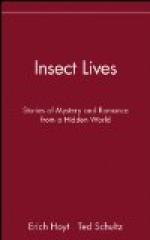The butterfly’s egg is absolutely and relatively of large size, and contains a considerable amount of yolk. As a rule we find that young animals hatched from such eggs resemble their parents rather closely and pass through no marked changes during their lives. A chicken, a crocodile, a dogfish, a cuttlefish, and a spider afford well-known examples of this rule. Land-animals, generally, produce young which are miniature copies of themselves, for example horses, dogs, and other mammals, snails and slugs, scorpions and earthworms. On the other hand, metamorphosis among animals is associated with eggs of small size, with aquatic habit, and with relatively low zoological rank. The young of a starfish, for example, has hardly a character in common with its parent, while a marine segmented worm and an oyster, unlike enough when adult, develop from closely similar larval forms. If we take a class of animals, the Crustacea, nearly allied to insects, we find that its more lowly members, such as ‘water-fleas’ and barnacles, pass through far more striking changes than its higher groups, such as lobsters and woodlice. But among the Insects, a class of predominantly terrestrial and aerial creatures producing large eggs, the highest groups undergo, as we shall see, the most profound changes. The life-story of the butterfly, then, well-known as it may be, furnishes a puzzling exception to some wide-reaching generalisations concerning animal development. And the student of science often finds that an exception to some rule is the key to a problem of the highest interest.
During many centuries naturalists have bent their energies to explain the difficulties presented by insect transformations. Aristotle, the first serious student of organised beings whose writings have been preserved for us, and William Harvey, the famous demonstrator of the mammalian blood circulation two thousand years later, agreed in regarding the pupa as a second egg. The egg laid by a butterfly had not, according to Harvey, enough store of food to provide for the building-up of a complex organism like the parent; only the imperfect larva could be produced from it. The larva was regarded as feeding voraciously for the purpose of acquiring a large store of nutritive material, after which it was believed to revert to the state of a second but far larger egg, the pupa, from which the winged insect could take origin. Others again, following de Reaumur (1734), have speculated whether the development of pupa within larva, and of winged insect within pupa might not be explained as abnormal births. But a comparison of the transformation of butterflies with simpler insect life-stories will convince the enquirer that no such heroic theories as these are necessary. It will be realised that even the most profound transformation among insects can be explained as a special case of growth.
CHAPTER II
GROWTH AND CHANGE




